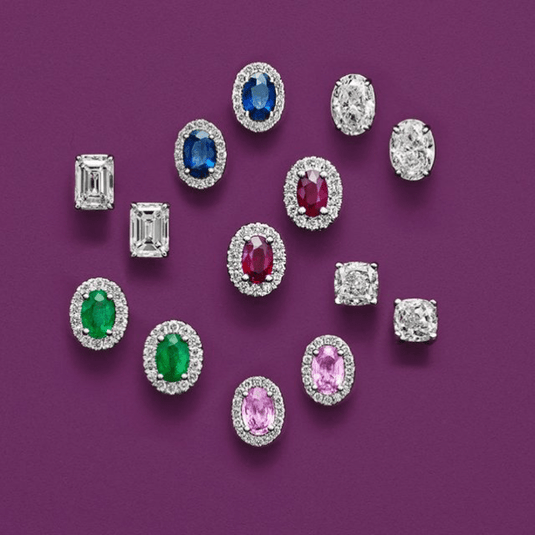When it comes to gemstones, one of the first things people notice is their shape. Whether it’s a glimmering diamond or a vibrant ruby, the cut of a stone significantly influences its beauty and brilliance. But what exactly does “cut” mean in the world of gemstones, and what are the terms that professionals use to describe the different shapes and structures? In this post, we will explore the essential terminology of gemstone cuts, delve into popular shapes, and examine how each cut affects the stone’s appearance. We will also touch on the elegant baguette shape and finish with a look at the unique world of cabochons.
Key Terminology in Gemstone Shapes
To fully appreciate gemstone cuts, it’s helpful to understand some of the key terms used to describe the structure and facets of a gem. Here are some fundamental terms that describe the cut and shape of a gemstone:
- Facet: A facet is one of the flat surfaces that make up the geometry of a gemstone, usually in a polygonal shape. These facets are carefully cut and polished to reflect light in the most beautiful way, contributing to the brilliance of the stone.
- Table: The table is the flat, topmost facet of a gemstone. It’s typically the largest facet and is the one most visible when looking at a gem. The table plays a critical role in the gemstone's overall light performance.
- Girdle: The girdle is the outer edge or perimeter of a gemstone, where the stone’s crown and pavilion meet. It acts like the gemstone’s "waist" and is an important reference point for determining the quality of the cut.
- Culet: The culet is the small facet at the very bottom of the gemstone’s pavilion. In some cuts, it’s a tiny point, while in others, it may be a flat facet. The culet is designed to protect the gem from damage, and in some designs, it can also enhance the stone’s brilliance.
- Crown: The crown is the upper portion of the gemstone, situated above the girdle. It’s the part that faces outward, where most of the gemstone's facets are cut to maximize its brilliance and color.
Popular Gemstone Cuts
Now that we’ve covered the basic terms, let’s explore the different shapes and cuts that are most commonly seen in gemstones.
Round Brilliant Cut
The round brilliant cut is arguably the most popular and iconic shape for diamonds and other gemstones. This cut features 58 facets, designed to maximize the amount of light reflected within the stone. The round shape is perfect for showcasing brilliance, making it a timeless choice for engagement rings and other fine jewelry.
Princess Cut
The princess cut is a square or rectangular cut with sharp, angular corners. This cut is famous for its contemporary look, offering a brilliant sparkle similar to the round cut, but with a more modern twist. The princess cut is also a versatile shape that complements many types of jewelry settings, making it a favorite for both diamonds and colored gemstones.
Emerald Cut
The emerald cut is known for its large, rectangular facets, which are step-cut rather than the triangular facets seen in brilliant cuts. This cut is ideal for stones that are clear and free of inclusions because its long, open facets allow the viewer to see deep into the gemstone. While the emerald cut is typically used for emeralds, it is also a popular choice for diamonds, as it enhances clarity while providing a sophisticated, elegant appearance.
Asscher Cut
The asscher cut is similar to the emerald cut but with a square shape rather than rectangular. It features stepped facets that give the stone a hall-of-mirrors effect, showcasing the gemstone’s clarity. Originally developed in the early 20th century, the asscher cut is making a comeback due to its vintage charm and striking geometric appearance.
Oval Cut
An oval cut is essentially an elongated version of the round brilliant cut. It offers the same brilliance but in a unique, oval shape that tends to appear larger than other cuts of the same carat weight. Oval cuts are often used for diamonds, sapphires, and other gemstones, providing an elegant yet subtle look.
Cushion Cut
The cushion cut is a hybrid between the round and princess cuts, featuring rounded corners and a soft, pillow-like shape. This cut combines the brilliance of a round cut with the vintage charm of a square shape, making it a great option for those who love a more romantic or antique look. Cushion cuts are often seen in vintage-style rings, as they evoke a sense of nostalgia and timeless elegance.
The Elegant Baguette Cut
The baguette cut is a distinctive rectangular or tapered shape with straight edges. It is typically used as an accent stone in jewelry, rather than as the focal point. The baguette cut is designed to highlight the clarity and color of the gemstone, as its large, open facets allow for a clearer view of the stone's internal structure. This cut is often used in modern and Art Deco-inspired designs, where clean lines and geometric patterns are celebrated.
Baguettes are often seen in side-stone settings for engagement rings, as well as in bracelet designs and earrings. Their sleek, elongated form provides an elegant contrast to rounder, more brilliant-cut stones, making them a versatile addition to a variety of jewelry pieces.
The Unique Beauty of Cabochon Cuts
While faceted stones dominate the world of gemstones, there is a category of gemstones that stands apart from the rest: cabochon cuts. Unlike faceted stones, cabochons are smooth, rounded gemstones that are not cut to reflect light in the same way. Instead, cabochons have a soft, polished dome shape, with no facets. The beauty of a cabochon lies in its smoothness and the way it enhances the natural color and internal characteristics of the stone.
Cabochons are often used for opaque or translucent stones, such as opals, moonstones, and turquoise. These stones may not have the clarity or brilliance of faceted gemstones, but their rich color and unique play of light make them visually stunning. The lack of facets allows the stone’s color to shine through more naturally, and in some cases, the unique internal features of the stone (such as a cat’s-eye effect in chrysoberyl or the milky glow of a moonstone) are better showcased.
The cabochon cut is especially favored in certain vintage and artisan jewelry styles, offering a bold yet subtle elegance. It's also a go-to choice for collectors and those looking for unique, one-of-a-kind pieces.
Conclusion
Gemstone cuts are an art form, with each shape offering a different way to showcase a stone’s natural beauty. From the sparkling brilliance of round cuts to the smooth elegance of cabochons, there’s a gemstone shape for every taste and style. Understanding the terminology and design choices behind each cut helps you appreciate the craftsmanship that goes into creating these precious gems. Whether you’re drawn to the timeless elegance of a princess cut, the geometric lines of a baguette, or the soft, natural appeal of a cabochon, each cut has its own distinct charm that makes it special.



